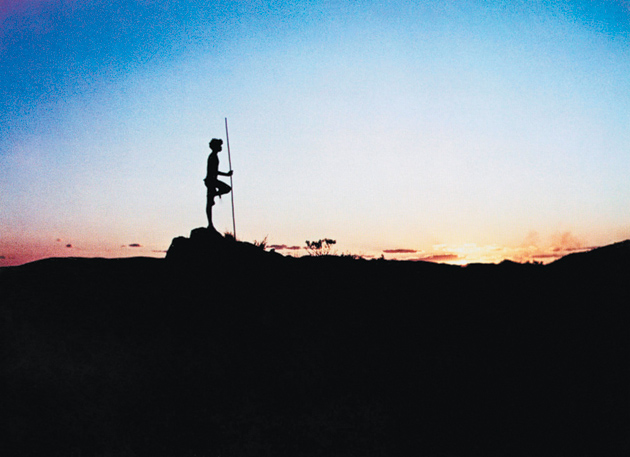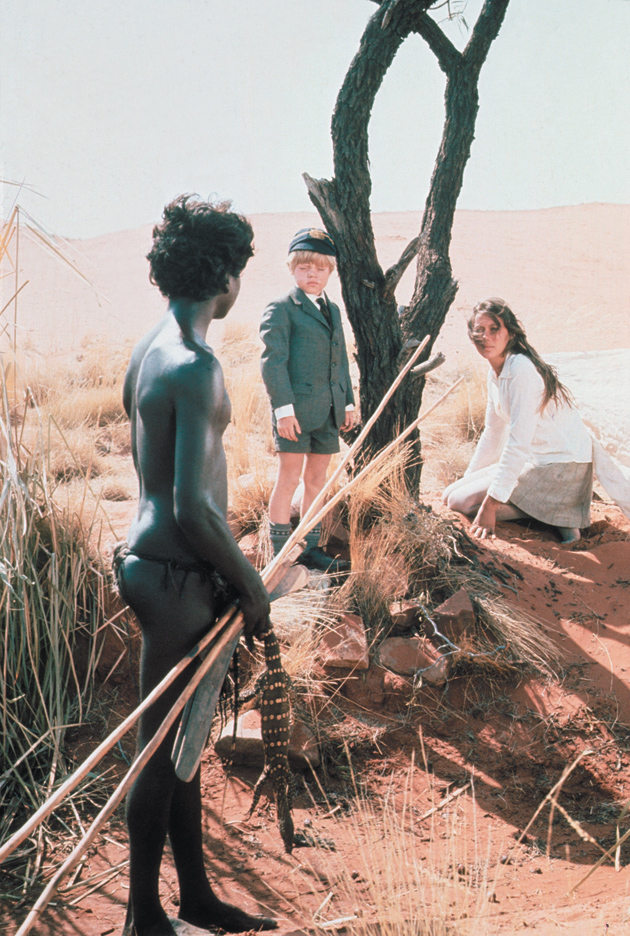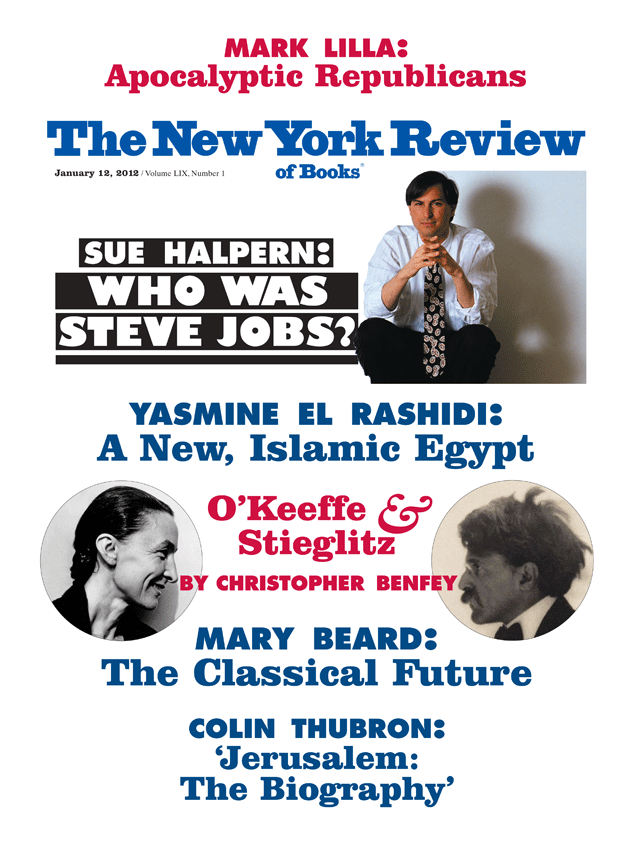It is the fate of certain novels to become classics only after they become movies, and then to be eclipsed by the movies that made them classics. James Vance Marshall’s enchanting short novel Walkabout was published in Britain in 1959. Yet it was not until Nicolas Roeg turned it into a film twelve years later that the book acquired an aura of wide renown, despite the fact that relatively few people had read it.* This is an ironic enough fate for a work of literature, but in fact the movie is so strikingly different from Marshall’s affecting parable as to verge on travesty. It is a brilliant travesty, though, one that adds a curious urgency to the book’s very different, apparently old-fashioned pleasures, which, as it turns out, have a good deal to tell us now.
Roeg’s film begins with a by now familiar evocation of the rote complaints about modern Western civilization—the monotonous dress of office workers, the synchronized pace of commuters, etc.—until we see one such office worker, still wearing his gray suit, driving his young daughter and son into the Australian desert in a black Volkswagen. The girl is around fourteen, the boy eight or nine. The girl darts a disapproving glance at her father. We can tell that she doesn’t trust him, that she’s scared.
Now he stops the car. He orders the girl and boy to lay out a picnic, and while they are doing so, he grabs a revolver out of the glove compartment, steps out of the car, and starts shooting at them. The girl pulls her brother behind a large rock. The father continues to shoot, commanding his daughter in a weird, robotic voice to come to him and to “bring him with you!” “Can’t waste time!” he says, as he douses the Volkswagen with gasoline and sets it on fire. Stepping back, he puts the gun in his mouth and pulls the trigger. His daughter watches in horrified disbelief as he drops to the ground in a sitting position. As flames engulf the car, he falls onto his back.
It is a scene of stunning violence, and its repercussions are felt throughout the movie. Stranded in the desert, the children are on the verge of dying of thirst and hunger when they come upon an Aborigine boy, who will lead them back to civilization. To ensure the survival of all three of them, he kills various creatures with terrific violence. In the end, out of some mysterious depression that we are meant to associate with encroaching civilization itself—at one point, he encounters a white hunter shooting game with a high-power rifle—the boy, like the children’s father, commits suicide. The story, scripted by avant-garde playwright Edward Bond, the British heir to Antonin Artaud’s “theater of cruelty,” is framed by violence and self-destruction.
In the film’s final scenes, however, the girl is not only restored to civilization but grown up and married to a man much like her father. Standing in their boxy apartment and holding his wife in his arms, he talks about his work, about the status of a colleague, about his own promotion, and similar mundane matters. She looks dreamily away and transports herself into what appears to be a memory of the “walkabout” in which the three children are swimming naked in a pool of water replenished by a gentle waterfall. And yet no such scene has appeared in the film, nor is it likely to have happened, since in fact she was terrified of the Aborigine’s nakedness. Rather, it seems that she has turned the complex experience of the walkabout into the type of exotic, idealized innocence that is the product of a supremely civilized state of mind. As the film ends, we hear a voice reciting one of A.E. Housman’s most famous poems:
Into my heart an air that kills
From yon far country blows:
What are those blue
remembered hills,
What spires, what farms
are those?That is the land of lost
content,
I see it shining plain,
The happy highways where
I went
And cannot come again.
Post-Woodstock, post-Manson, Roeg’s startling film is very much of its disillusioned moment, the early 1970s, when the naive enthusiasms of love-ins and flower children have given way to cynicism and despair. The very memory of such naiveté and innocence is “an air that kills” the disabused spirit. Neither in civilization nor in the wilderness can one escape the elemental reality of destruction. What is left for the girl is a lie about life, which will protect her against the lie of her existence even as it makes it easier for her to live out her self-deceit. If the Aborigine boy’s spirit survives at all, if she is able to recall him as a pure soul incapable of lying, it is only because he killed himself—an honest self-obliteration that is contrasted with the father’s demented self-destruction. For Roeg, only violence and death do not lie. It is the glamorous apocalypticism of a director who made one of his next movies with David Bowie.
Advertisement
“It was silent and dark, and the children were afraid.” That is how the novel begins. With the cadences of the First Story, we are transported to the primacy of storytelling: “And the earth was without form, and void; and darkness was upon the face of the deep.”
James Vance Marshall’s Walkabout —the London-born author’s real name is Donald Gordon Payne—resembles reflective fictions like Marjorie Kinnan Rawlings’s The Yearling or John Steinbeck’s The Red Pony. Indeed, the book’s original title was The Children. The story is about children, and it is meant to be read by the eternal child that is the greenest part of the adult mind. If innocence is tested here, it is not condemned as a naive illusion.
In the novel the two children find themselves alone in the Australian wilderness when the plane they are taking from Charleston, South Carolina, to Adelaide crashes. On the brink of exhaustion and starvation, they encounter the Aborigine. “Kurura,” he tells them, a word that they come to construe as meaning “follow me.” And so they do.
Part fairy tale, part moral parable, Marshall’s short novel reveals its depths on its surface. Writing about the stranded children, he says:
Coddled in babyhood, psychoanalyzed in childhood, nourished on predigested patent foods, provided with continuous push-button entertainment, the basic realities of life were something they’d never had to face.
Having neatly summed up the simple cultural and intellectual context of his tale, as simply as if describing some desert fauna, Marshall gets down to what really interests him: the tale itself.
Marshall portrays the white children as alienated from the “basic realities of life.” The Aborigine, by contrast, lives amid them. “He knew what reality was,” we are told. The life of the people he belongs to is “unbelievably simple.” Marshall goes on:
Their lives were utterly uncomplicated because they were devoted to one purpose, dedicated in their entirety to the waging of one battle: the battle with death…. Keeping him at bay was the Aboriginals’ full-time job: the job they’d been doing for twenty thousand years: the job they were good at.
For all the elements of a classic adventure story in Walkabout, the adventure is essentially spiritual. The two children are thrust into a situation where the everyday structures of distraction have been peeled away from what they conceal: the brute fact of mortality. Behind the reassuring familiarity of the children’s “comfortable home in Charleston, South Carolina,” is the old tale of “the scrimmage of appetite,” as someone once called it: the ruthless struggle for food, drink, shelter, and health. In the “primeval desolation” of the desert, they will learn that life is bounded and hounded by death.
Primeval storyteller that he is, Marshall is frank about his choice of a wilderness as the proving ground of his two young characters. The girl’s name is Mary and the boy’s is Peter. They will experience a redemption from their fallen, civilized state in the comfortable South Carolina suburbs, and even a kind of resurrection of the spirit. But what is somewhat daring in Marshall’s unpretentious little parable is that the bushboy himself is the Christ figure. His “walkabout” is his own ordeal by temptation. Though the nature of his temptation is never made explicit, it is clear what it is. He can abandon the two white children to die. He can kill them out of fear and tribal hatred. He can ravish the girl. Instead he comes to the conclusion, in the narrator’s words, that “unless he looked after them, they would die.” The narrator continues: “It was his people’s way to accept individuals as they were: to help, not to criticize, the sick, the blind and the maimed.” The nameless bushboy is the spirit of love itself.
Readers falling into the book from the movie might at first be put off by what they feel is Marshall’s patronizing idealization of the Aborigine boy. It is true that much of what Marshall attributes to Aborigine culture, including the ritual significance of the walkabout, seems mostly to be his own concoction. Marshall himself appears to lose the thread of his conception of Aborigine life when, less than twenty pages after invoking the Aborigines’ compassionate nature, he defines the walkabout as “a selective test which weeded out and exterminated the weaker members of the tribe, and ensured that only the fittest survived to father children.”
Advertisement
Marshall may be guilty of romantic excess here and there, yet his idealizations are justified by his unsentimental grasp of social reality. At one point, the bushboy seems about to touch Mary. “The idea of being manhandled by a naked black boy appalled her,” Marshall writes, “struck at the root of one of the basic principles of her civilized code. It was terrifying; revolting; obscene. Back in Charleston, it would have got the darkie lynched.” Later, when Mary suddenly catches the bushboy looking at her in wonder as she is bathing naked in a pool of water, she gives him such a look of terror that he believes the death spirit has sentenced him to die. So certain is he of the death spirit’s plans for him that he eventually wills himself to die (the ability to die by autosuggestion perhaps being another of Marshall’s fanciful versions of Aborigine culture). Mary is his murderer.
Mary, however, is also his vessel. Two years after the forced integration of an American public school in Little Rock, Arkansas, just as the issue of race was starting to ignite a revolution in American life, Marshall is bringing Christianity back to its moral sources. Having, in a sense, killed the bushboy through the spirit of hatred, Mary becomes the instrument by which the boy’s spirit of love and forgiveness lives on. For despite knowing that Mary’s terrified glance has spelled his doom, the bushboy decides that he will help the children find their way back home. In the process, he teaches Peter to survive by catching fish in Aboriginal fashion—that is to say, he uses a primitive, pre-Christian technique to teach Peter how to become a true Christian: Simon, the fisher of souls. And when the bushboy dies, he does so with his head in Mary’s lap, smiling at her gently:
It was the smile that broke Mary’s heart: that last forgiving smile. Before, she had seen only as through a glass darkly, but now she saw face to face. And in that moment of truth all her inbred fears and inhibitions were sponged away, and she saw that the world which she had thought was split in two was one.
Saved by a black savage, the two white children absorb his clement, generous spirit on their way back to civilization. “Kurura,” says Peter to his sister at the end of the novel, and you feel that he is liberating the true spirit of Christianity from Christianity itself.
There is nothing labored about any of this, partly because it is unobtrusively woven into Marshall’s beautiful descriptions of the desert landscape, as if love were as fundamental a part of the physical universe as the elements themselves. Partly, too, Marshall’s modestly subversive variation on the Christian myth is simply another version of the necessity of people to care for one another, which is often the moral of the greatest children’s literature. That theme is there at the very beginning of the book, when Mary remembers seeing the burning plane after the crash and watching “the figure of the Navigating Officer carrying the pilot and clambering out of the wreckage. In the heat of the explosion, he glowed white-hot, disintegrating.” The unforgettable scene is a foreshadowing of Mary and Peter’s own discovery, in the disintegrating white heat of the desert, that the navigator’s selfless act of trying to save the pilot exists beyond the color of one’s skin or the place of one’s birth.
Roeg’s film also opens with a fire, though his retelling of the story takes a wholly different path. To go from the widely known film to the obscure book is to move from a nightmare vision of collective corruption to the timelessness of a simple story about the “basic realities of life.” You may find that to go from the film to the book is similar to the experience of Mary and Peter. You will journey from the hub of darkness, as it were, to the heart of light—from the dehumanizing refinements of civilization to the innocent wilderness itself.
This Issue
January 12, 2012
Do the Classics Have a Future?
Convenience
Republicans for Revolution
-
*
This essay will appear, in somewhat different form, as the introduction to a new edition of James Vance Marshall’s Walkabout, to be published by New York Review Books in January. The film version, also titled Walkabout, directed by Nicolas Roeg, is available on DVD from Criterion. ↩




